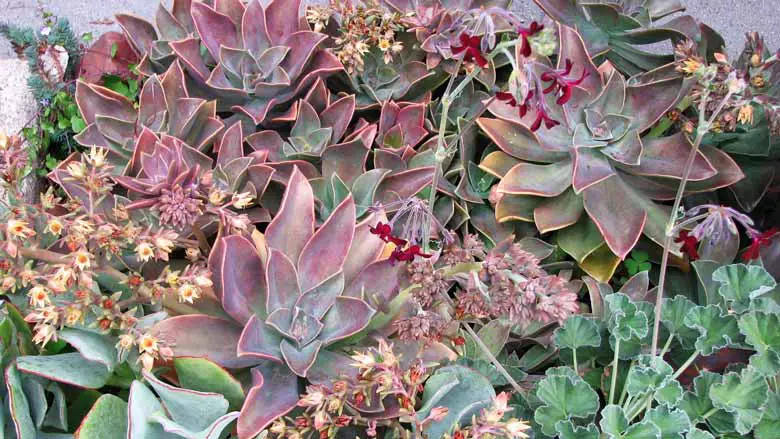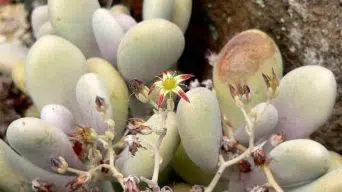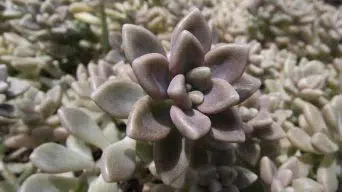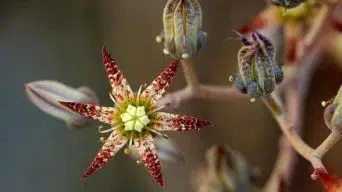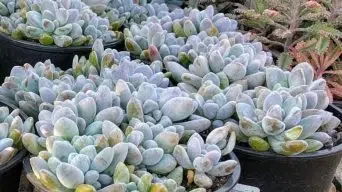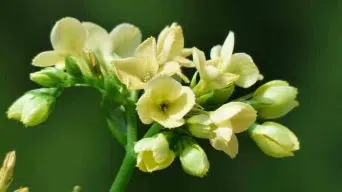The Graptopetalum ‘Fred Ives’ are succulent plants that will thrive with minimal care.
They are drought-tolerant and have a wide variety of colors, which makes them perfect for any garden!
Graptopetalum ‘Fred Ives’ plants are also easy to take care of, so you won’t need any special knowledge or skills when caring for them.
It’s perfect for beginners or those who don’t have much experience gardening. You can’t go wrong with this beauty!
In this piece, you will learn everything about how to care for and propagate your Graptopetalum ‘Fred Ives’ plants.
Overview
The Graptopetalum ‘Fred Ives’ succulent is native to Mexico and is a hybrid between Graptopetalum paraguayense and Echeveria gibbiflora.
This Graptopetalum species produce large clumps of rosettes. These grow up to 8 inches (20 cm) tall and 1 foot (30 cm) in diameter, but the plants themselves can reach 2 feet (60cm).
The fleshy, thick leaves of the Graptopetalum ‘Fred Ives’ Succulent Plant are rich with colors that can change from pinks to blue-greens to purples and oranges, depending on the season and the growing conditions.
The Graptopetalum ‘Fred Ives’ flowers are a beautiful yellow with red centers and appear on arching stems up to 2 feet (60 cm) long in summer. The plants bloom only once per year, but the blooms last for months!
How To Care for Graptopetalum ‘Fred Ives’
Graptopetalum ‘Fred Ives’ care is pretty easy, to be honest.
This Graptopetalum has some general needs common among all succulents and a few individual needs you need to keep in mind.
Sun Exposure & Light Requirements
Graptopetalum ‘Fred Ives’ thrives best in full sun to partial shade, with bright light and ample airflow.
Graptopetalum ‘Fred Ives’ plants will also survive in lower light, but it should be noted that the lower the light availability, the less colorful ‘Fred Ives’ will be, taking on a more greenish tone.
When grown outdoors, Graptopetalum ‘Fred Ives’ plants generally require 6 hours of sun and bright light exposure and will benefit from protection during the midday summer sun.
If Graptopetalum ‘Fred Ives’ is to be grown indoors, it should be placed on an east or west-facing windowsill, where Graptopetalum ‘Fred Ives’ will receive full sun exposure.
Keeping Graptopetalum ‘Fred Ives’ in lower light will encourage a more compact growth habit and increase Graptopetalum ‘Fred Ives’ overall leaf size.
However, as Graptopetalum ‘Fred Ives’ enjoys bright light and being outdoors, moving Graptopetalums into partial shade may result in yellowing leaves due to lack of sunlight.
Watering Requirements
Graptopetalum ‘Fred Ives’ needs to be watered every one or two weeks, depending on the season and air humidity.
It should only be watered when the soil is completely dry.
Graptopetalum ‘Fred Ives’ can go for long periods without water and still look healthy, but the growth of Graptopetalum will slow down, and your plant will be more prone to root rot.
It’s important not to let its roots sit in water or pooled water for too long since this makes them much more susceptible to root rot.
Sticking your finger into the potting soil is an excellent way to check if Graptopetalum ‘Fred Ives’ needs water.
If it feels moist at all, you should probably refrain from watering Graptopetalum ‘Fred Ives’.
Soil Requirements
The Graptopetalum ‘Fred Ives’ plant requires a well-draining soil mix for proper growth.
Graptopetalums are succulents, so it’s vital that the soil is well-drained and will not hold moisture for extended periods.
A good suggestion for Graptopetalums is to use a cactus mix or succulent soil.
If you want to make your own Graptopetalum ‘Fred Ives’ soil, combine equal parts of topsoil with coarse sand, and add perlite or vermiculite (never both) until the soil is slightly fluffy when squeezed in hand.
Temperature and Humidity
Graptopetalum ‘Fred Ives’ plants prefer a temperature range of 65° to 75 °F (18° to 24° C) during the day and about 10 degrees less at night.
Although Graptopetalum ‘Fred Ives’ can handle cold down to 20 °F (-6.7° C), it is best not to expose your succulents outdoors when temperatures are below 50 F (10° C ).
Graptopetalum ‘Fred Ives’ plants like humidity of around 50% whether they are inside or outside, with slightly higher humidity levels preferred when it is kept as a potted plant.
Excessively high humidity can cause the Graptopetalum to develop root rot.
Fertilizing
Graptopetalum ‘Fred Ives’ grows best in soils that are lightly fertilized.
Use a well-balanced liquid fertilizer with minor elements every two weeks during the active growing season. Plants in containers will appreciate an occasional application of soluble houseplant fertilizer.
It should not be fertilized too much, or the Graptopetalum ‘Fred Ives’ plant will be burned and lose its natural shape and character.
Potting and Repotting
Potting and repotting Graptopetalum ‘Fred Ives’ can be done at any time of year.
Graptopetalum ‘Fred Ives’ needs to be repotted into a container with fresh soil that is the same or slightly larger than the previous pot. This succulent seems to like small containers with good drainage.
It takes a while to become established, so you should not repot Graptopetalum ‘Fred Ives’ too often.
If you are potting Graptopetalum ‘Fred Ives’ into a larger container, it is important to prune back the roots before you place Graptopetalum ‘Fred Ives’ in its new home.
Graptopetalum ‘Fred Ives’ has shallow roots that can be easily damaged when repotting. It doesn’t like having its root pruned, but the damage is usually fairly minimal, and it should grow new roots quickly.
If your Graptopetalum is already in a too-large container, you can repot it into a smaller container. Still, Graptopetalum ‘ Fred Ives’ will also be happy staying where it is.
Pruning
Graptopetalum ‘Fred Ives’ can be easily pruned to keep it compact. Spring is the best time to prune them, but it can be done anytime.
Graptopetalum ‘Fred Ives’ does not show signs of distress when being pruned, so it can cut back hard, and you will have a fuller looking plant.
This plant will be cut back easily with clean scissors or a sharp razor blade.
One of the most important things when pruning Graptopetalum ‘Fred Ives’ is to make sure you leave a leaf node in there.
You want to remove any dead leaves and cut back about 1-2 inches above a leaf node (the bumpy part where new growth will come out).
The Graptopetalum ‘Fred Ives’ will grow back quickly, and you will have a fuller plant.
Pests and Diseases
Graptopetalum ‘Fred Ives’ succulents are resistant to most diseases and only have a few common pests: aphids, vine weevil larvae, mealybugs, and scale.
- Aphids are tiny (about 1/8″), soft-bodied, pear-shaped insects that can reproduce very quickly. Their diet consists of the juices found within plant leaves. In large numbers, they can cause great damage to your plants and potentially kill them if left unchecked.
- Vine Weevil larvae and adults feed on plant roots, while the female lays her eggs in the soil near Graptopetalum ‘Fred Ives’ plants. These underground pests cause damage to the roots that can stunt or kill your Graptopetalum ‘Fred Ives’ succulent plant.
- Mealybugs appear as waxy, white bumps on Graptopetalum ‘Fred Ives’ plant leaves and stems. It is a sap-sucking insect that can cause yellowing of leaves and stunted plant growth. They can spread quickly, so removing any you find on Graptopetalum ‘Fred Ives’ plants is essential, or they will quickly multiply.
- Scale is a hard-shelled, brownish, or black insect that is immobile once it has attached to Graptopetalum ‘Fred Ives’ plants. These pests have piercing mouth parts that suck on plant juices.
The most common disease Graptopetalum ‘Fred Ives’ succulents are susceptible to is powdery mildew.
This fungal infection appears as a white powder on Graptopetalum ‘Fred Ives’ plants around the edges of the leaves.
It is a contagious disease that spreads quickly, so remove Graptopetalum ‘Fred Ives’ succulents with powdery mildew to avoid infecting other plants.
The best way to prevent problems with Graptopetalum ‘Fred Ives’ pests and diseases is proper plant care to monitor your Graptopetalums often for signs of them.
If you see any, act quickly to eradicate these Graptopetalum ‘Fred Ives’ pests and diseases to protect your Graptopetalum ‘Fred Ives’ plants.
How to Care for Graptopetalum ‘Fred Ives’ in Winter
Graptopetalum ‘Fred Ives’ care in the wintertime is simple.
Some tips are:
- Graptopetalums are not frost tolerant. Graptopetalums should not be left outdoors when the temperatures are forecasted to drop below freezing.
- Graptopetalum ‘Fred Ives’ water needs to be reduced in wintertime. They should not be kept soggy wet and should only be watered when the soil is dry.
- It is best to water Graptopetalum ‘Fred Ives’ in the morning so that they will have dry air in the evening. Graptopetalums do not like wet feet.
- Do not fertilize Graptopetalum ‘Fred Ives’ in winter.
- If Graptopetalum ‘Fred Ives’ is potted, it is best to keep them in a temperature from 55 – 65F/13 – 18C during the winter.
- -Graptopetalum ‘Fred Ives’ should be kept in partial sunlight during the winter. Graptopetalums like some protection from intense sun, so if you can locate them where they get morning sun and afternoon shade, that’s perfect.
How To Propagate Graptopetalum ‘Fred Ives’
Graptopetalum ‘Fred Ives’ can be easily propagated from leaves or offsets.
Leaves
To propagate Graptopetalum ‘Fred Ives’ from a leaf cutting, remove one or more leaves at the end of a stem that is just beginning to branch.
The Graptopetalum ‘Fred Ives’ leaves should be short, plump, and fleshy with no prickles on the edges. Avoid leaves that are elongated, slim, and have prickles along the edges.
After removing the Graptopetalum ‘Fred Ives’ leaves, allow them to callous for a few days. This can be done by placing the leaves in a plastic bag or putting them on a sunny windowsill.
Once the Graptopetalum ‘Fred Ives’ leaves have been calloused over, plant the leaf cuttings in the soil.
Graptopetalum ‘Fred Ives’ will grow roots along the edges of leaves, so be careful to plant the cuttings with the most growth possible facing downward toward the ground.
Use a light potting mix that drains well and has some organic matter in it, such as peat moss or sand. Graptopetalum ‘Fred Ives’ does not need to be fertilized.
Keep the Graptopetalum ‘Fred Ives’ leaf cuttings in an area with bright, indirect sunlight and a temperature between 50 F – 95 F (10 C-35 C).
When Graptopetalum ‘Fred Ives’ grows from leaf cuttings, it tends to grow vigorously for about six months before it begins to grow more slowly.
Graptopetalum ‘Fred Ives’ will continue growing for several years, producing offsets along the way.
Offsets
Graptopetalum ‘Fred Ives’ can also be propagated from offsets.
Graptopetalum ‘Fred Ives’ begins to produce offsets after growing for at least a year, often sooner.
Offsets are small Graptopetalum ‘Fred Ives’ plants that grow on the stem above where it branches off the mother plant.
The offsets are easy to remove. Graptopetalum ‘Fred Ives’ often produces multiple offsets at a time, so you will be able to propagate several Graptopetalum ‘Fred Ives’ plants from one plant.
Start by removing Graptopetalum ‘Fred Ives’ offsets from the stem that the mother Graptopetalum ‘Fred Ives’ plant grows on.
The Graptopetalum ‘Fred Ives’ offsets should be plump, fleshy, and short. Avoid any Graptopetalum ‘Fred Ives’ offset with a long or thin neck.
Once you have Graptopetalum ‘Fred Ives’ offsets in your possession, allow them to dry for a few days.
Place offsets into the soil and keep them slightly moist for a couple of weeks. Graptopetalum ‘Fred Ives’ offsets should begin to develop roots without any problem.
Once Graptopetalum ‘Fred Ives’ offsets have developed root systems, fully hydrate the Graptopetalum ‘Fred Ives’ offsets and move the Graptopetalums into direct sunlight.
Eventually, the offsets will become Graptopetalum ‘Fred Ives’ plants in their own right.
You can use Graptopetalum ‘Fred Ives’ offsets to propagate Graptopetalum ‘Fred Ives’ indefinitely.
Is the Graptopetalum ‘Fred Ives’ Toxic?
Graptopetalum ‘Fred Ives’ is non-toxic to humans and animals.
Graptopetalum ‘Fred Ives’ has no known adverse side effects on people or pets.
It does not contain harmful chemicals, so it is safe to have around pets and children.
Final Thoughts
If you’re looking for a new addition to your garden, the Graptopetalum ‘Fred Ives’ is perfect!
This succulent will thrive with minimal care and give off an amazing color palette all year round.
Plus, it’s easy to take care of, so you won’t need any special knowledge or skills when caring for it.
All you need is some time and patience!

